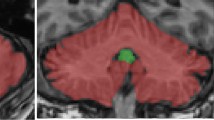Abstract
Structural grey matter abnormalities have been described in adult-onset primary torsion dystonia (AOPTD). Altered spatial discrimination thresholds are found in familial and sporadic AOPTD and in some unaffected relatives who may be non-manifesting gene carriers. Our hypothesis was that a subset of unaffected relatives with abnormal spatial acuity would have associated structural abnormalities. Twenty-eight unaffected relatives of patients with familial cervical dystonia, 24 relatives of patients with sporadic cervical dystonia and 27 control subjects were recruited. Spatial discrimination thresholds (SDTs) were determined using a grating orientation task. High-resolution magnetic resonance imaging (MRI) images (1.5 T) were analysed using voxel-based morphometry. Unaffected familial relatives with abnormal SDTs had reduced caudate grey matter volume (GMV) bilaterally relative to those with normal SDTs (right Z = 3.45, left Z = 3.81), where there was a negative correlation between SDTs and GMV (r = −0.76, r 2 = 0.58, p < 0.0001). Familial relatives also had bilateral sensory cortical expansion relative to unrelated controls (right Z = 4.02, left Z = 3.79). Unaffected relatives of patients with sporadic cervical dystonia who had abnormal SDTs had reduced putaminal GMV bilaterally compared with those with normal SDTs (right Z = 3.96, left Z = 3.45). Sensory abnormalities in some unaffected relatives correlate with a striatal substrate and may be a marker of genetic susceptibility in these individuals. Further investigation of grey matter changes as a candidate endophenotype may assist future genetic studies of dystonia.




Similar content being viewed by others
References
Waddy HM, Fletcher NA, Harding AE, Marsden CD (1991) A genetic study of idiopathic focal dystonias. Ann Neurol 29:320–324. doi:10.1002/ana.410290315
Jarman PR, del Grosso N, Valente EM, Leube B, Cassetta E, Bentivoglio AR, Waddy HM, Uitti RJ, Maraganore DM, Albanese A, Frontali M, Auburger G, Bressman SB, Wood NW, Nygaard TG (1999) Primary torsion dystonia: the search for genes is not over. J Neurol Neurosurg Psychiatry 67:395–397. doi:10.1136/jnnp.67.3.395
Tinazzi M, Rosso T, Fiaschi A (2003) Role of the somatosensory system in primary dystonia. Mov Disord 18:605–622. doi:10.1002/mds.10398
Frima N, Nasir J, Grunewald R (2008) Abnormal vibration-induced illusion of movement in idiopathic focal dystonia: an endophenotypic marker? Mov Disord 23:373–377. doi:10.1002/mds.21838
Meunier S, Hallett M (2005) Endophenotyping: a window to the pathophysiology of dystonia. Neurology 65:792–793. doi:10.1212/01.wnl.0000177919.02950.4a
O’Dwyer JP, O’Riordan S, Saunders-Pullman R, Bressman SB, Molloy F, Lynch T, Hutchinson M (2005) Sensory abnormalities in unaffected relatives in familial adult-onset dystonia. Neurology 65:938–940. doi:10.1212/01.wnl.0000176068.23983.a8
Walsh R, O’Dwyer JP, Sheikh I, O’Riordan S, Lynch T, Hutchinson M (2007) Sporadic adult onset dystonia: sensory abnormalities as an endophenotype in unaffected relatives. J Neurol Neurosurg Psychiatry 78:980–983. doi:10.1136/jnnp.2006.105585
Garraux G, Bauer A, Hanakawa T, Wu T, Kansaku K, Hallett M (2004) Changes in brain anatomy in focal hand dystonia. Ann Neurol 55:736–739. doi:10.1002/ana.20113
Black KJ, Ongur D, Perlmutter JS (1998) Putamen volume in idiopathic focal dystonia. Neurology 51:819–824
Colosimo C, Pantano P, Calistri V, Totaro P, Fabbrini G, Berardelli A (2005) Diffusion tensor imaging in primary cervical dystonia. J Neurol Neurosurg Psychiatry 76:1591–1593. doi:10.1136/jnnp.2004.056614
Etgen T, Muhlau M, Gaser C, Sander D (2006) Bilateral putaminal grey-matter increase in primary blepharospasm. J Neurol Neurosurg Psychiatry 77:1017–1020. doi:10.1136/jnnp.2005.087148
Bressman SB, de Leon D, Brin MF, Greene PE, Fahn S, Breakefield XO, Risch NJ (1989) Idiopathic dystonia among Ashkenazi Jews: evidence for autosomal dominant inheritance. Ann Neurol 26:612–620. doi:10.1002/ana.410260505
Ashburner J, Friston KJ (2005) Unified segmentation. Neuroimage 26:839–851. doi:10.1016/j.neuroimage.2005.02.018
Maldjian JA, Laurienti PJ, Kraft RA, Burdette JH (2003) An automated method for neuroanatomic and cytoarchitectonic atlas-based interrogation of fMRI data sets. Neuroimage 19:1233–1239. doi:10.1016/S1053-8119(03)00169-1
Genovese CR, Lazar NA, Nichols T (2002) Thresholding of statistical maps in functional neuroimaging using the false discovery rate. Neuroimage 15:870–878. doi:10.1006/nimg.2001.1037
Fox PT, Laird AR, Fox SP, Fox PM, Uecker AM, Crank M, Koenig SF, Lancaster JL (2005) BrainMap taxonomy of experimental design: description and evaluation. Hum Brain Mapp 25:185–198. doi:10.1002/hbm.20141
Obermann M, Yaldizli O, De Greiff A, Lachenmayer ML, Buhl AR, Tumczak F, Gizewski ER, Diener HC, Maschke M (2007) Morphometric changes of sensorimotor structures in focal dystonia. Mov Disord 22:1117–1123. doi:10.1002/mds.21495
Delmaire C, Vidailhet M, Elbaz A, Bourdain F, Bleton J-P, Sangla S, Meunier S, Terrier A, Lehéricy S (2007) Structural abnormalities in the cerebellum and sensorimotor circuit in writer’s cramp. Neurology 69:376–380. doi:10.1212/01.wnl.0000266591.49624.1a
Moore CE, Schady W (2000) Investigation of the functional correlates of reorganization within the human somatosensory cortex. Brain 123:1883–1895. doi:10.1093/brain/123.9.1883
Brown LL, Schneider JS, Lidsky TI (1997) Sensory and cognitive functions of the basal ganglia. Curr Opin Neurobiol 7:157–163. doi:10.1016/S0959-4388(97)80003-7
Peller M, Zeuner KE, Munchau A, Quatarone A, Weiss M, Knutzen A, Hallett M, Deuschl G, Siebner HR (2006) The basal ganglia are hyperactive during the discrimination of tactile stimuli in writer’s cramp. Brain 129:2697–2708. doi:10.1093/brain/awl181
Sathian K, Zangaladze A, Green J, Vitek JL, DeLong MR (1997) Tactile spatial acuity and roughness discrimination: impairments due to aging and Parkinson’s disease. Neurology 49:168–177
Murase N, Kaji R, Shimazu H, Katayama-Hirpta M, Ikeda A, Kohara N, Kimura J, Shibasaki H, Rothwell JC (2000) Abnormal premovement gating of somatosensory input in writer’s cramp. Brain 123:1813–1829. doi:10.1093/brain/123.9.1813
Carbon M, Su S, Dhawan V, Raymond D, Bressman S, Eidelberg D (2004) Regional metabolism in primary torsion dystonia: effects of penetrance and genotype. Neurology 62:1384–1390
Edwards MJ, Huang YZ, Wood NW, Rothwell JC, Bhatia KP (2003) Different patterns of electrophysiological deficits in manifesting and non-manifesting carriers of the DYT1 mutation. Brain 126:2074–2080. doi:10.1093/brain/awg209
Acknowledgements
This study was funded by Dystonia Ireland and a University College Dublin Seed Funding grant.
Conflict of interest statement
The authors report no conflicts of interest.
Author information
Authors and Affiliations
Corresponding author
Rights and permissions
About this article
Cite this article
Walsh, R.A., Whelan, R., O’Dwyer, J. et al. Striatal morphology correlates with sensory abnormalities in unaffected relatives of cervical dystonia patients. J Neurol 256, 1307–1313 (2009). https://doi.org/10.1007/s00415-009-5119-1
Received:
Revised:
Accepted:
Published:
Issue Date:
DOI: https://doi.org/10.1007/s00415-009-5119-1




